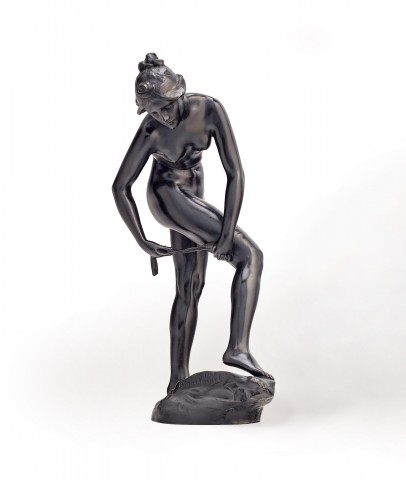DIANA WOUNDED, 1905
BERTRAM MACKENNAL
bronze
36.5 cm height
signed and dated at base: 1905 / B. Mackennal
Private collection, Melbourne
Thence by descent
Private collection, Melbourne
Royal Academy, London, 1906, cat. 1648 (another example)
Bertram Mackennal: The Fifth Balnaves Sculpture Project, Art Gallery of New South Wales, Sydney, 17 August – 4 November 2007 (another example)
Edwards, D., Bertram Mackennal: The Fifth Balnaves Sculpture Project, Art Gallery of New South Wales, Sydney, 2007, pp. 66 – 68, 116 – 118 (illus., p. 66, another example)
Diana Wounded, 1907 – 08, life-size marble version, Tate Gallery, London, acquired by the Chantrey Bequest, 1908
The mythological tales of Diana, virgin huntress, inspired many artists over the centuries, Titian's painting Diana and Actaeon in London's National Gallery being one of the Renaissance master's greatest works. Bertram Mackennal's bronze Diana Wounded, 1905 is a far cry from Actaeon being torn to pieces by his own hounds. Moreover, she is stripped of her godly attributes, ‘her bow and hounds’, and presented as a blithe nude in her virgin splendour. Her contemporary appearance, as a nubile Edwardian beauty, has been commented on by several writers.1 Like his fellow Symbolists of the 1890s Mackennal portrayed the femmes fatales of his time: Sarah Bernhardt and the past Circe, 1893 (bronze, National Gallery of Victoria), and Salome, c.1895 (bronze, Art Gallery of New South Wales). Things changed in the first decade of the new century. His women became outwardly more genteel, though refinement did not reduce their considerable appeal.
Diana, in Roman mythology, was the moon goddess of the hunt and birthing, equated with the Greek Artemis, daughter of Zeus and brother of the sun god Apollo. Jupiter gave Diana permission 'to live in perpetual celibacy' and, as 'the patroness of chastity', 'to shun the society of men'.2 Mythological references are avoided in Mackennal's bronze. Diana Wounded is even more tongue-in-cheek. The vicious Roman moon goddess in Ovid's Metamorphoses is inverted. It is she, not the quarry Damasichthon, son of Amphion and Niobe, who is injured in the leg'.3 Taking into account the association of Diana with 'heavenly' and 'divine', Mackennal carried this further. Divine in looks rather than status, she is a sight perilously tantalising to the mortal male. The action of bandaging her thigh, inspired by the more explicit sight of 'a model doing up her stocking', effectively enabled the artist to show off her bodily attributes without loss of modesty.4 This teasing play between the appealing and the unobtainable epitomised that beguiling blend of poise and pleasure so typical of la belle époque and its English Edwardian counterpart. Although calling freely upon ancient Greek and Roman sculptures of the goddess of love, Aphrodite and Venus, she is a thoroughly modern Edwardian maiden. Effectively using the contrapposto pose, Mackennal created an ideal image endowed with grace, but sensuous of modelling. When Mackennal made a marble life-sized version in 1907–08, he crowned Diana with her crescent moon. It was smartly acquired by the Chantrey Bequest and given to London's Tate Gallery in 1908. The Times called it 'one of the most beautiful nudes that any sculptor of the British school has produced'.5 The artist thought it one of his best works too.
1. Edwards, D., Bertram Mackennal: The Fifth Balnaves Sculpture Project, Art Gallery of New South Wales, Sydney, 2007, pp. 67–68
2. Lemprière, J., Lemprière's Classical Dictionary of Proper Names mentioned in Ancient Authors, Routledge and Kegan Paul Ltd, London, revised edition, 1972, p. 204
3. Hutchison, N., 'Here I am!'; sexual imagery and its role in the sculpture of Bertram Mackennal', in Edwards, op. cit., p. 116
4. ibid.
5.'The Royal Academy: second notice', Times, London, 8 May 1908, p. 6, quoted in Edwards, op. cit., p. 67
DAVID THOMAS
